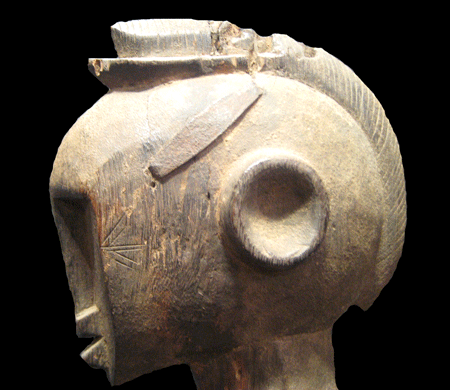Senufo Wooden Pombibele Sculpture of a Hermaphrodite, 20th Century CE
Wood
9 x 39
PF.4564 (LSO)
Further images
This powerful and dynamic piece is a pombilele or “rhythm pounder” sculpture, made by the Senufo people of the Ivory Coast and Mali. It is highly unusual in terms of...
This powerful and dynamic piece is a pombilele or “rhythm pounder” sculpture, made by the Senufo people of the Ivory Coast and Mali. It is highly unusual in terms of proportions – notably the size of the base – and also in terms of what it represents, as hermaphroditic pombilele are very rare. Indeed, it is the first such example we have seen. It represents a standing figure with short legs, a very elongated, curved torso, a small chest – with breasts – and a long neck giving way to a head of notable sophistication and authority. The face is sternly reductivist, with an incised face cut away from the nose and protuberant mouth. The head is surmounted with a blunt crest. Detailing is limited, save for the prominent male genitalia, a pendant around the neck and a prominent umbilicus. This adds to the piece’s dramatic impact.
The Senufo group, based in the Ivory Coast and Mali area, has a long history of using highly decorated objects in many aspects of everyday life. However, their extremely high level of skill in woodcarving is nowhere better seen than in the realm of their magical-religious art. At the heart of Senufo society is a patriarchal groups of elders known as the Poro society, which is responsible for many religious and more urbane functions to do with the running of the tribal group. Their ceremonial events are often associated with dancing, music and the use of Pombilele sculptures.
“Pombilele” literally translates as “those who give birth”, and traditionally constitute a pair of figures (one male, one female) who represent primordial humanity and the ancestry of all humankind. Most examples, however, are of single, female figures, making this example somewhat unusual. The appearance of these figures is relatively homogenous, being tall, slim and somewhat angular. However, a Poro elder often based the personal characteristics of each sculpture upon a dream or vision. The figures were used as pounding devices (holding each arm) to keep the rhythm for dancing, or were stood for purposes of contemplation in the middle of the Poro society’s sacred enclosures. They are also used for the interment of prominent Poro members; they are carried to the graveside with the dead body, then used to tamp down the earth on top of the grave, to ensure that the spirit of the dead is directed to the afterlife rather than returning to haunt the living.
The significance of the hermaphroditism is uncertain, although it is always an issue of considerable importance in African artworks. This is a striking and attractive piece of African art.
The Senufo group, based in the Ivory Coast and Mali area, has a long history of using highly decorated objects in many aspects of everyday life. However, their extremely high level of skill in woodcarving is nowhere better seen than in the realm of their magical-religious art. At the heart of Senufo society is a patriarchal groups of elders known as the Poro society, which is responsible for many religious and more urbane functions to do with the running of the tribal group. Their ceremonial events are often associated with dancing, music and the use of Pombilele sculptures.
“Pombilele” literally translates as “those who give birth”, and traditionally constitute a pair of figures (one male, one female) who represent primordial humanity and the ancestry of all humankind. Most examples, however, are of single, female figures, making this example somewhat unusual. The appearance of these figures is relatively homogenous, being tall, slim and somewhat angular. However, a Poro elder often based the personal characteristics of each sculpture upon a dream or vision. The figures were used as pounding devices (holding each arm) to keep the rhythm for dancing, or were stood for purposes of contemplation in the middle of the Poro society’s sacred enclosures. They are also used for the interment of prominent Poro members; they are carried to the graveside with the dead body, then used to tamp down the earth on top of the grave, to ensure that the spirit of the dead is directed to the afterlife rather than returning to haunt the living.
The significance of the hermaphroditism is uncertain, although it is always an issue of considerable importance in African artworks. This is a striking and attractive piece of African art.
Literature
V24





